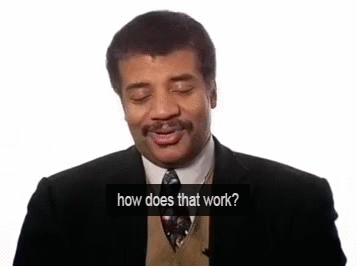Latest news about Bitcoin and all cryptocurrencies. Your daily crypto news habit.
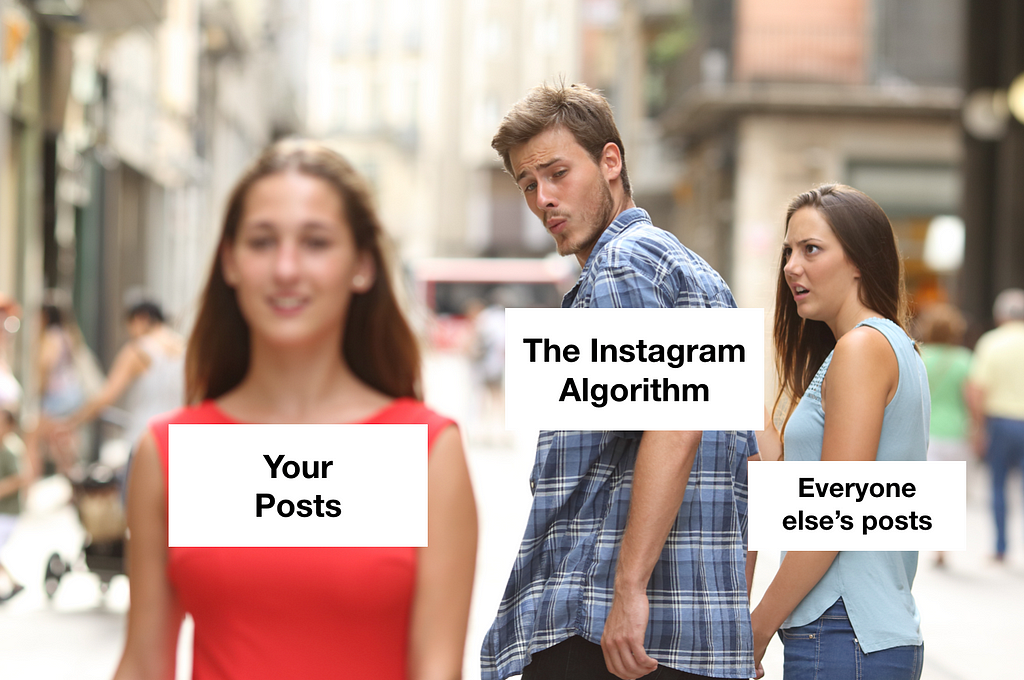
If you’re reading this, you’re probably wondering why no one is seeing your Instagram posts after the latest algorithm change.
Fear not, the key to deciphering this algorithm change, and all future ones, lies in understanding the principles behind what the algorithm does, how it works, and how Instagram improves it.
Stop looking for hacks to fool the algorithm. It’s not sustainable. Scrambling to adapt your content to the latest change in the algorithm is only a short-term band-aid. In the long run, this will distract you from making the necessary changes to your Instagram strategy to help you become algorithm-resistant, no matter how many times it changes in the future.
So, what are the principles behind the Instagram algorithm?
To understand the principles behind it, we first need to understand Instagram as a company.
Instagram is a company owned by Facebook and they exist to make money from advertising by capturing and selling your attention.
Instagram doesn’t exist to “create community” or connect you to your friends, they exist to make money from advertising and their ultimate purpose is to create value (make money) for their shareholders.
The more time you spend on Instagram, the more money they make.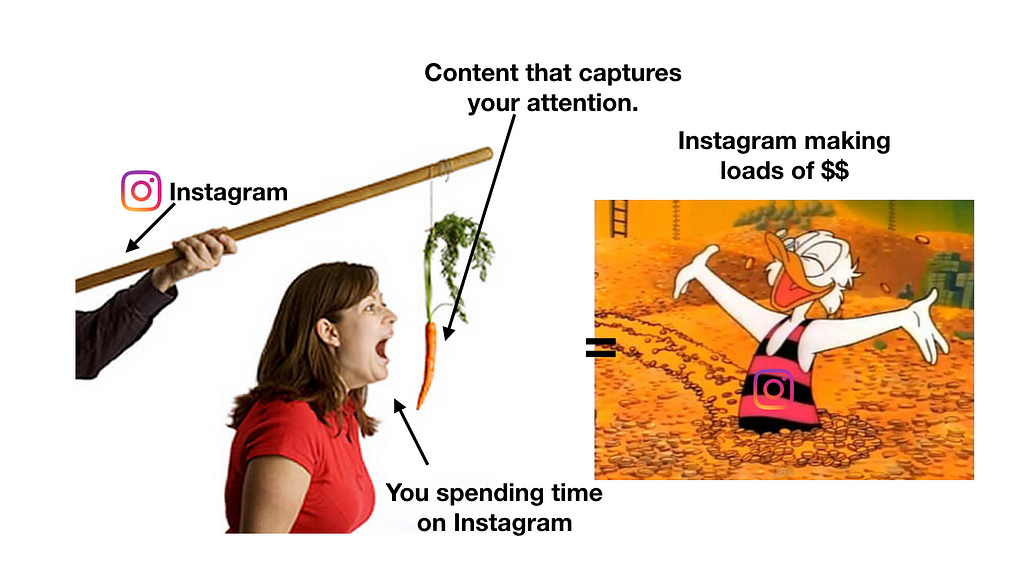
Because of that, everything they do revolves around capturing your attention for as long as possible in order to sell it to advertisers for the highest price possible.
They analyze your user behavior data to understand how to capture your attention for as long as possible.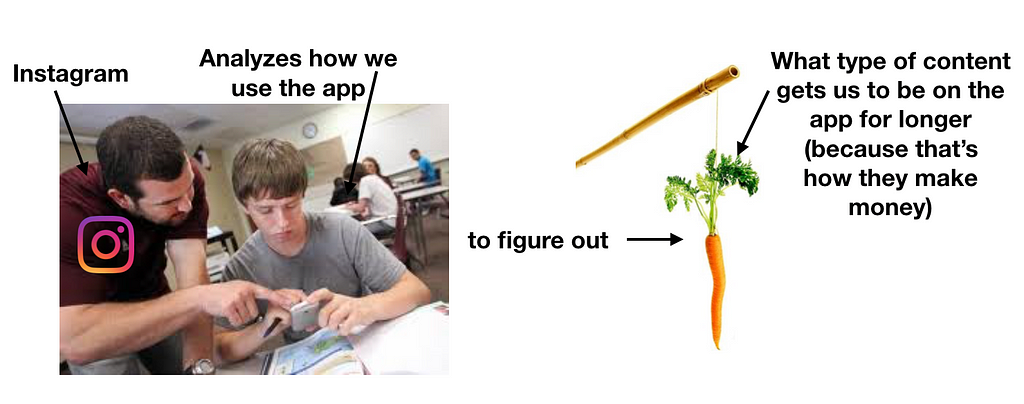 Instagram keeps track of every single thing you do while using the app. That includes the time your eyes spend viewing a particular post, the number of times you view someone’s profile or even what the microphone records when you’re using the app.
Instagram keeps track of every single thing you do while using the app. That includes the time your eyes spend viewing a particular post, the number of times you view someone’s profile or even what the microphone records when you’re using the app.
To figure out how they can improve Instagram so that we spend as much time as possible on the app (so they can sell that to advertisers), they analyze our user behavior data (how we use the app) to identify what keeps us on the app for longer.
The posts that keep us on Instagram for longer are posts with high engagement.
Although there are many reasons why we use Instagram (their UI, social pressure, etc.) when it comes to content, Instagram has determined that we tend to stay on the app for longer when we see posts that cause us to interact with them more, in comparison to other posts. More specifically, posts with high engagement (engagement of a post = number of likes, comments, shares, saves, etc. divided by the total number of followers.).
This makes sense. We like, comment, share, save and spend time seeing posts that capture our attention. The ones that don't, we just ignore.
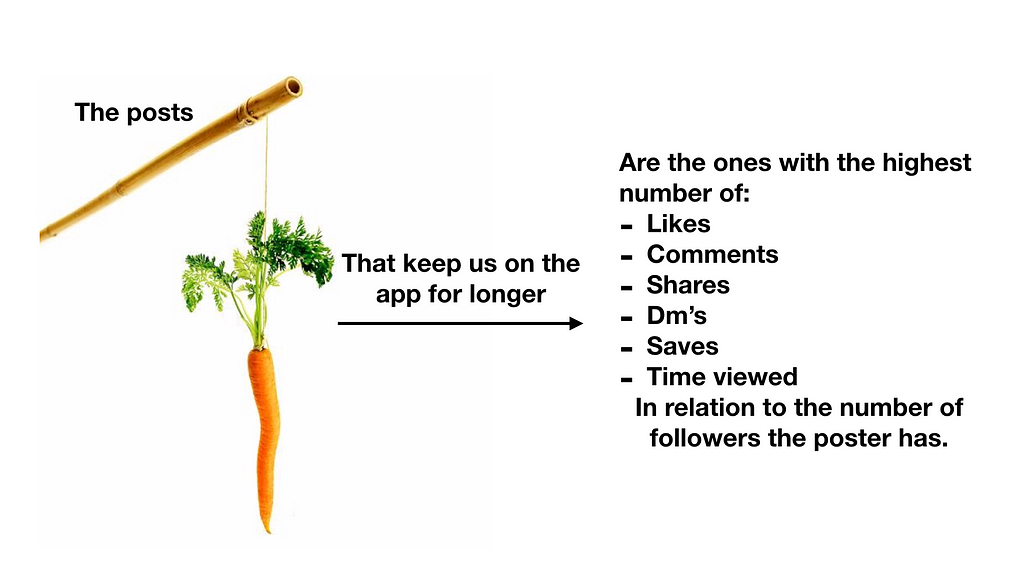 Interactions, in Instagram’s case, refers to likes, comments, shares, DMs, time spent viewing the post, saves, and a few other metrics none of us know Instagram is measuring. By dividing these metrics by the number of total followers the poster has, we get a post’s engagement. The higher the engagement, the more likely we are to pay attention to the post.The Instagram Algorithm was built in to show you high-engagement posts first.
Interactions, in Instagram’s case, refers to likes, comments, shares, DMs, time spent viewing the post, saves, and a few other metrics none of us know Instagram is measuring. By dividing these metrics by the number of total followers the poster has, we get a post’s engagement. The higher the engagement, the more likely we are to pay attention to the post.The Instagram Algorithm was built in to show you high-engagement posts first.
At some point, Instagram also measured that showing us posts of the people we follow in chronological order is less effective at keeping us on the app for longer in comparison to showing us the most highly-engaged with photos first. Because of this, they created the Instagram algorithm. Its purpose is to show every user the post they are most likely to engage with (from the people they follow) on the home feed first.
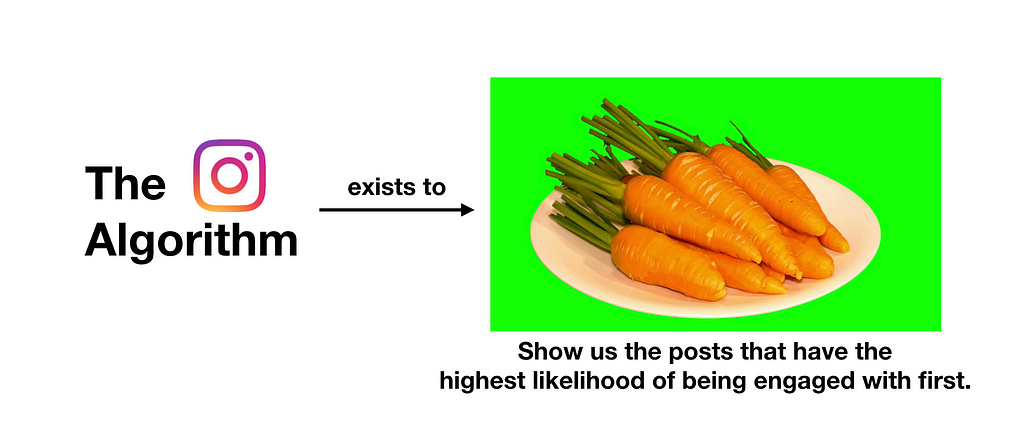 Making sure users see high-engagement posts as soon as they open the app is of utmost importance to Instagram because those posts are the ones that keep us on the app for the longest (and they make more money the longer we are on the app). That’s what the algorithm does. It serves us the posts we are most likely to engage with, first.For now, it decides where and how to show our posts in the following way:
Making sure users see high-engagement posts as soon as they open the app is of utmost importance to Instagram because those posts are the ones that keep us on the app for the longest (and they make more money the longer we are on the app). That’s what the algorithm does. It serves us the posts we are most likely to engage with, first.For now, it decides where and how to show our posts in the following way:
- We post something.
2. The Instagram algorithm shows that post to a small percentage of our total followers and measures how they engage with that post in comparison to similar posts on similar days and times in the past (we are predictable creatures).
3. If that small subset of our followers engages with the post faster and more frequently than comparable posts in the past, the algorithm will prioritize the post and show it to a larger percentage of our followers (because it’s likely to capture their attention). If that small subset engages with the post slower and less frequently than comparable posts in the past, the algorithm will down-rank the post and show it to a smaller percentage of our followers (because it’s less likely to capture their attention).
4. Once it knows what percentage of our audience it’s going to be shown to, it measures how likely it is to be engaged with in comparison to the other posts available from the other accounts each of our followers Follow. The more likely our post is to be engaged with in comparison to all other posts available at the time we post (Instagram has the technology to calculate that), the higher it is to be shown in someone’s Home Feed and other people’s Explorer Page. Since everyone that follows us also follows different people, our post will be shown in a different order to everyone.
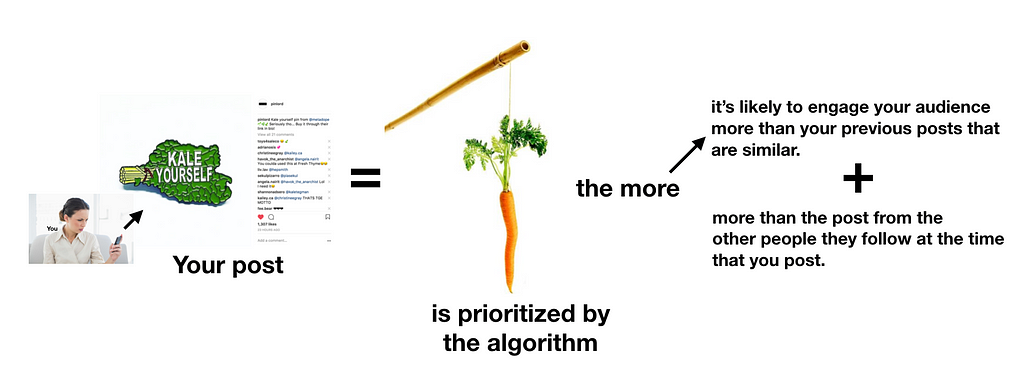 Being algorithm-resistant means that the algorithm will show our posts to the largest percentage of our audience and rank it highly on each of their Home Feeds every time we post.But that will change whenever Instagram develops new technology to better measure what posts are the most likely to be engaged with.
Being algorithm-resistant means that the algorithm will show our posts to the largest percentage of our audience and rank it highly on each of their Home Feeds every time we post.But that will change whenever Instagram develops new technology to better measure what posts are the most likely to be engaged with.
That’s why the algorithm will continue to change (forever…)! Because Instagram maximizes profits by maximizing the time you use the app, they’ll continue to invest in and develop technology that better identifies which posts we are most likely to be engaged with and keep us on the app for longer.
So to be algorithm-resistant, we need to create super engaging content that is highly differentiated, within in a category that isn’t saturated.
Seriously, there are no tricks or hacks around this. To not be negatively affected by each new Instagram algorithm change, we need to create content that Instagram is incentivized to keep prioritizing, and that is the content that will keep people’s attention for the longest.
More often than not, that’s content that people react to (high-engagement) and that people seek out because it’s scarce (highly differentiated and in a category that isn’t saturated). If you want to be algorithm-resistant, you need to learn how to create both!
 Create super engaging content.
Create super engaging content.
Knowing that the total percentage of our audience that sees our posts depends on how a small subset of them engages with each new post, we have to make every post as engaging as possible. Super engaging content is created by:
- Measuring our engagement data to understand what captures our audience’s attention the most: Before you measure your engagement, you need to be creating new content frequently (or you won’t have anything to measure). Once you are, we can measure which posts your audience engages with most to get an objective understanding of what gets our audience’s attention. To find this information, use your Posts engagement data in your Instagram Insights page.
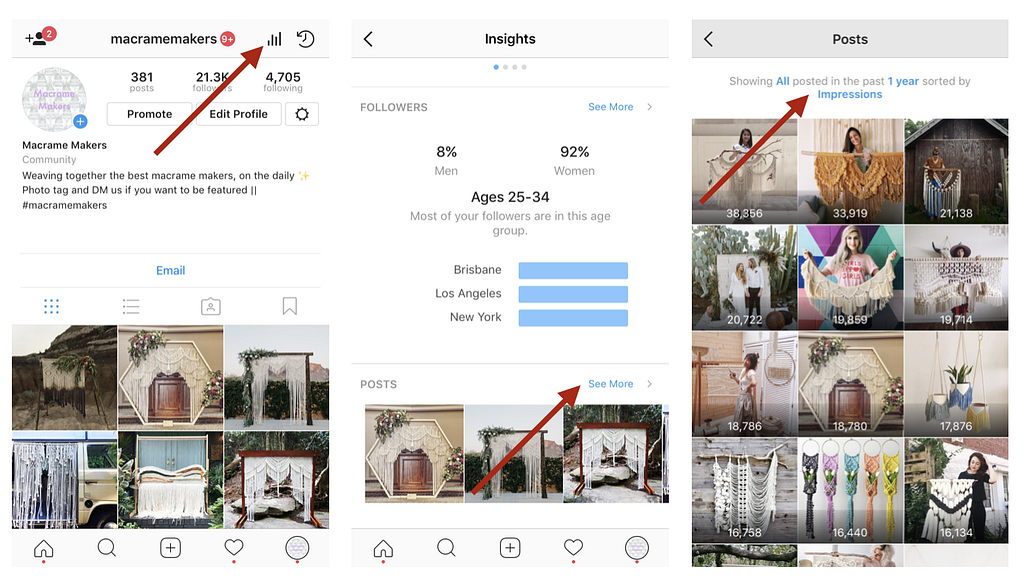 To measure your engagement data, go to your Instagram Insights page, tap into the Posts section, tap in the filter section at the top within that page, and filter All posts by Engagement within the last 6 months and Apply.
To measure your engagement data, go to your Instagram Insights page, tap into the Posts section, tap in the filter section at the top within that page, and filter All posts by Engagement within the last 6 months and Apply.
- Making our high-engagement content event better: Once our engagement data has shown us which types of posts our audience wants, work hard to make those type of posts even better and more nuanced.
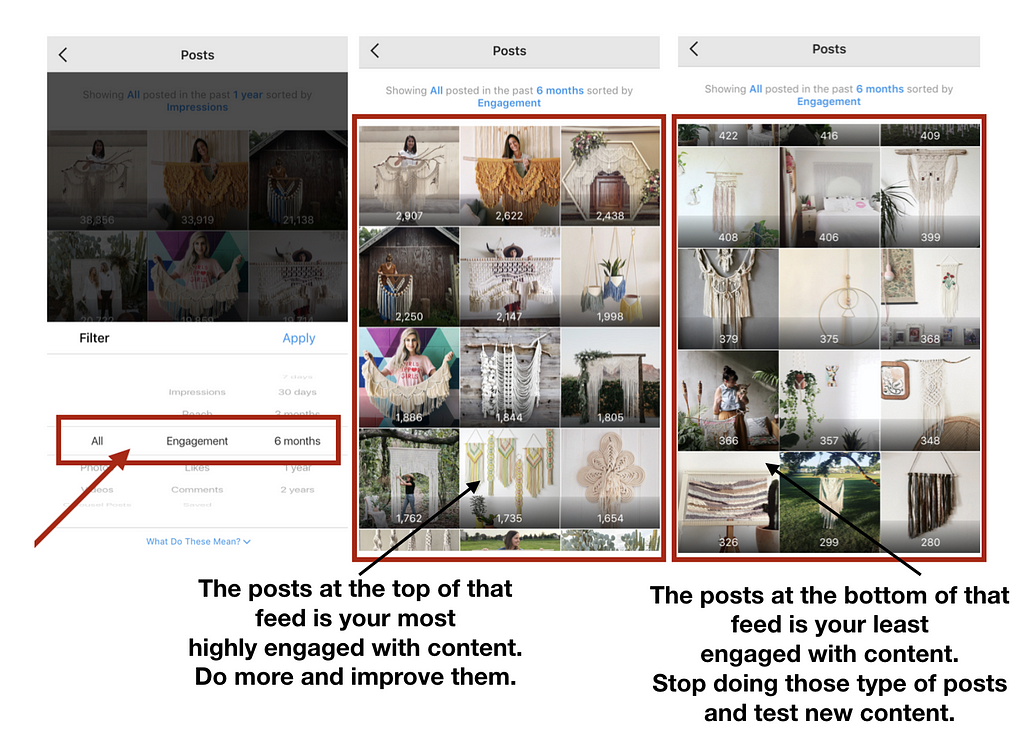 At the top of this feed, you’ll see the posts which get the highest engagement from your audience. These are the posts your audience has had the strongest emotional connection within the last 6 months. Those are your high engagement posts and they are the ones you need to continue to post and improve upon. In the case of one of my accounts, @macramemakers, the engagement data made it very clear to me that my audience likes to see complex macrame pieces with the person who makes it in the photo.
At the top of this feed, you’ll see the posts which get the highest engagement from your audience. These are the posts your audience has had the strongest emotional connection within the last 6 months. Those are your high engagement posts and they are the ones you need to continue to post and improve upon. In the case of one of my accounts, @macramemakers, the engagement data made it very clear to me that my audience likes to see complex macrame pieces with the person who makes it in the photo.
- Continually testing new content: Our follower’s tastes change over time, so to be able to identify how it changes and to keep them engaged we have to continually post new types of content that we think they might enjoy, and again, use our engagement data to measure if it actually did.
Be highly differentiated within a content category that isn’t saturated.
Knowing that how highly we rank in each of our follower’s Home Feeds depends on how likely our post is to be engaged with in comparison to all other posts available at that time, we have to be as differentiated as possible to everyone else our followers Follow. We do this by being highly differentiated within a content category, and that is usually accomplished by:
- Posting at the right times: Since how highly our posts rank on our follower’s Home Feeds depends on how it compares to the posts from the other accounts they follow at the time that we post, we need to understand at what time our followers like to engage with our posts. To do that, use your Instagram Insights data or more powerful tools like Squarelovin.
 To find what times are best to post for your audience, go to your Instagram Insights, then the Audience tab and scroll to the bottom, where below Gender, you’ll find Followers. Here you can toggle between Hours and Days to see when they are the most engaged with. You want to post at the times in which they are most engaged. In my account @pinlord’s case, my audience engages most on Mondays and Fridays, at 12–3pm. Those are the times my posts are most likely to be highly ranked on their Home Feeds.
To find what times are best to post for your audience, go to your Instagram Insights, then the Audience tab and scroll to the bottom, where below Gender, you’ll find Followers. Here you can toggle between Hours and Days to see when they are the most engaged with. You want to post at the times in which they are most engaged. In my account @pinlord’s case, my audience engages most on Mondays and Fridays, at 12–3pm. Those are the times my posts are most likely to be highly ranked on their Home Feeds.
- Focusing on creating content in categories that aren’t saturated: Since the algorithm decides how highly to rank someone depending on their likelihood of engaging the user in comparison to everyone else they follow, if there are a lot of people that create content similar to ours, the lower our chance is to always be ranked highly (simply because it is less likely that we will create the most engaging content when there are a lot of people creating content similar to ours). That’s why you want to create content in categories that aren’t saturated with other content creators. A simple way to gauge how many people are creating content similar to yours is by seeing how many posts there are in the most popular hashtag about whatever topic you create content about. The more posts there are within that hashtag, the more saturated it is likely to be.
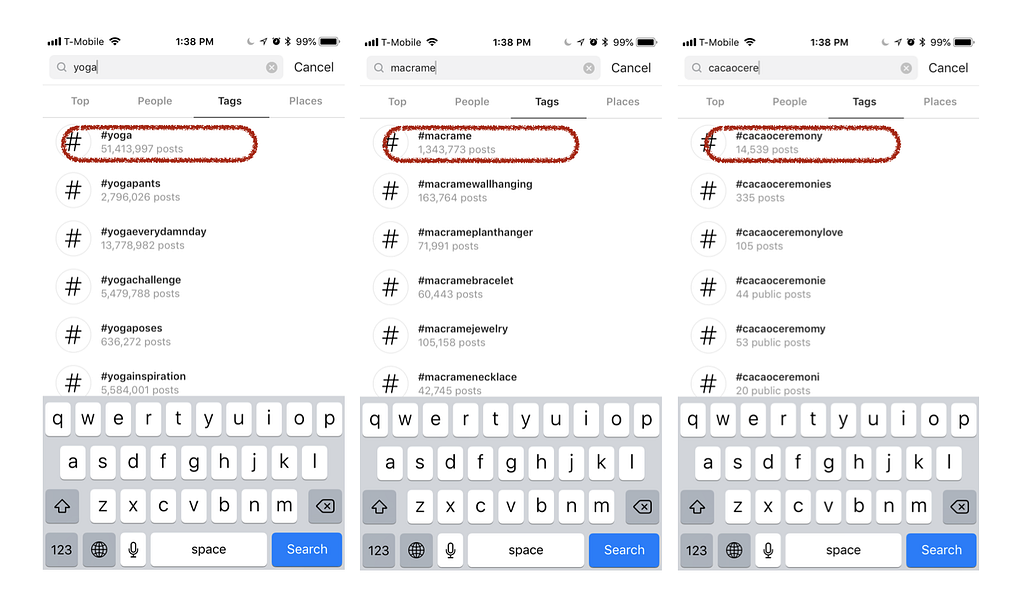 For example, I want to start a new Instagram account that is likely to do well with the algorithm, but I’m not sure what topic I want to focus on yet. Three topics that interest me are yoga, macrame and cacao ceremonies (weird tastes, I know…). I search for the main hashtag in each of these categories and these are the number of posts that show up in each hashtag: #Yoga has over 51,000,000 posts, #macrame over 1,300,000 posts and #cacaoceremony only slightly more than 14,000. If I want to be in the least saturated topic, which of these categories should I choose? By far, I’ll have a higher likelihood of being the most engaging account within the Cacao Ceremony category in comparison to the other ones (because I’ll be competing with less content).
For example, I want to start a new Instagram account that is likely to do well with the algorithm, but I’m not sure what topic I want to focus on yet. Three topics that interest me are yoga, macrame and cacao ceremonies (weird tastes, I know…). I search for the main hashtag in each of these categories and these are the number of posts that show up in each hashtag: #Yoga has over 51,000,000 posts, #macrame over 1,300,000 posts and #cacaoceremony only slightly more than 14,000. If I want to be in the least saturated topic, which of these categories should I choose? By far, I’ll have a higher likelihood of being the most engaging account within the Cacao Ceremony category in comparison to the other ones (because I’ll be competing with less content).
- Be as differentiated as possible within our content category: On the flip side, if we are the most engaging content creator within our category, we’ll always be ranked highly. The catch is, it’s very very very difficult to be the most engaging content creator within a category. BUT, the more differentiated we are, the higher our chances are. What differentiated means truly depends on what type of content category we’re talking about, so the more creative you are, the better. What’s essential to keep in mind is that people have options when it comes to choosing who they follow if they’re interested in a particular topic, and Follows (and attention) are a scarce resource. Why would they realistically follow you over everyone else who is creating similar content to you? If we don’t have a crystal clear answer to this, it’s likely that we aren’t very differentiated.
 The algorithm will always change, but Instagram won’t.
The algorithm will always change, but Instagram won’t.
Instagram is a company that exists to maximize profit. They do that by maximizing the time we spend on the app so they can sell our attention to advertisers. They continually improve the algorithm (and the app in general) to show us the content that will engage us the most, because that content is what keeps us on the app for longer. To be algorithm change-resistant, we need to be able to continually create high-engagement content so it has high a likelihood of being favored by the algorithm now and in the future. In the long-run, there is no other way to avoid being a victim of an algorithm change. Now that you know that, it’s up to you to put in the work!
 Thanks so much for taking the time to read this! If you enjoyed it, please give it a bunch of claps and read my other articles ❤ It’ll help more people see this story and learn about how they can be algorithm-resistant as well!
Thanks so much for taking the time to read this! If you enjoyed it, please give it a bunch of claps and read my other articles ❤ It’ll help more people see this story and learn about how they can be algorithm-resistant as well!
The Principles Behind How The Instagram Algorithm Works was originally published in Hacker Noon on Medium, where people are continuing the conversation by highlighting and responding to this story.
Disclaimer
The views and opinions expressed in this article are solely those of the authors and do not reflect the views of Bitcoin Insider. Every investment and trading move involves risk - this is especially true for cryptocurrencies given their volatility. We strongly advise our readers to conduct their own research when making a decision.
